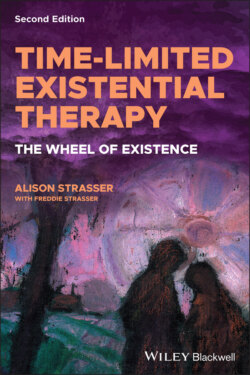Читать книгу Time-Limited Existential Therapy - Alison Strasser - Страница 19
Core of the Wheel: Time and Self
ОглавлениеIn this updated version of the Wheel of Existence, the segments revolve around time and the ever‐changing self at its centre.
Time as one of the tenets of existence refers to how we engage with or experience time and temporality within the dimensions of the past, present and future. Time is the way we relate to the hum of temporality and all of the other ontological givens.
Time itself is a social and personal construct that furnishes us comfortably with a convenient structure as we move from birth to death, from day through to night, from experience to experience, from moment to moment. Time is closely connected with endings of all types, evoking different reactions, and is worked with and addressed in therapy.
The Wheel of Existence figuratively demonstrates how time can be deemed as the centre of our existence. It informs every micro‐second of our waking and sleeping life and influences the way we understand our past, live in the present and imagine the future. Time both influences and interacts with all the elements that constitute the ‘expression of the sum total of our particular way of being with or engaging in the world’ (Strasser, 1999, p. 11).
Time also interacts with and influences our concept of our self. In existential terms, we are continually reacting to what is happening to and around us and we are constantly making moment‐to‐moment passive and active choices. The self continually shifts and flows between feeling worthy and secure and inferior, doubtful and insecure, as we find ourselves in relationship with the ontological givens and our ontic responses. The self is thus in constant flux.
Time and the self will be explored further in Chapter 2.
